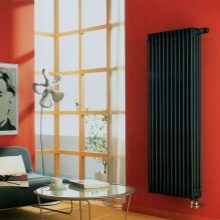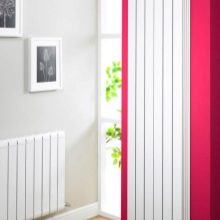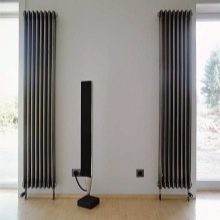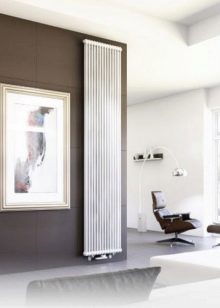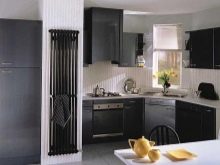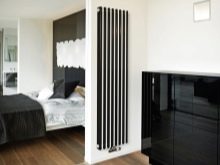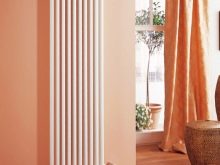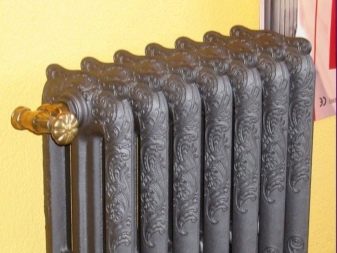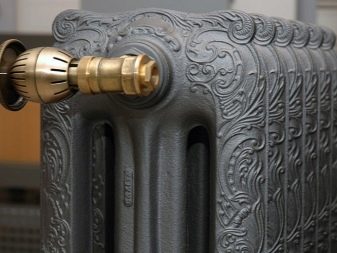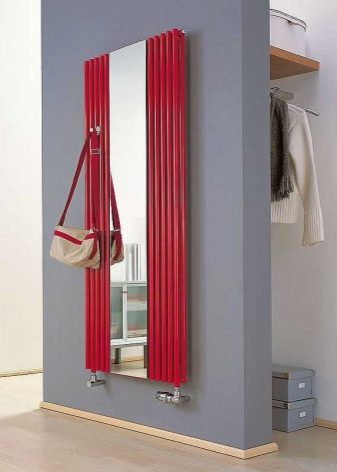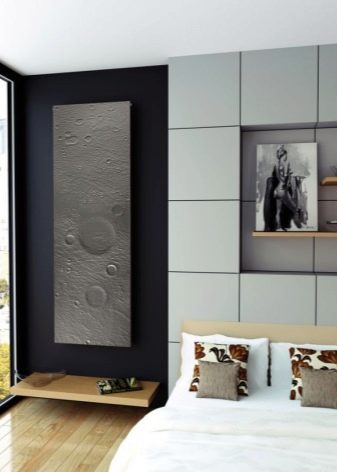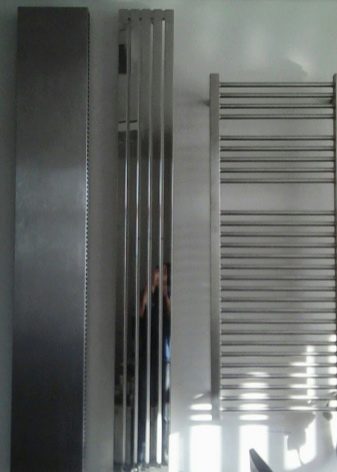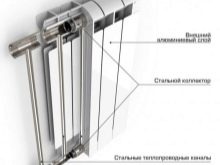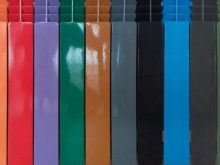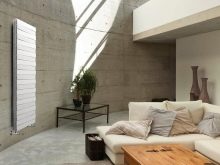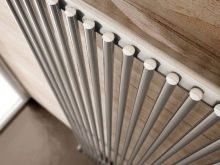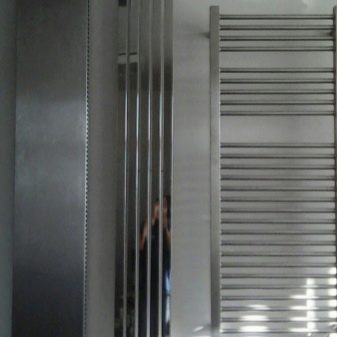Features of high heating radiators
Vertical radiators - the same heating devices as conventional batteries are used to heat houses and apartments, but these designs become extremely relevant when it comes to modern, non-standard layouts of living rooms and the lack of free space.
The advantages of high radiators
Compared with standard sizes This type of heating system has its advantages:
- such batteries save free space and fit perfectly into the narrow planes of the walls;
- vertical models are able to maintain the most comfortable microclimate due to good heat transfer;
- despite the unusual appearance, these are designs of various configurations, which give the interior originality;
- vertical position allows you to install a sufficient number of fasteners, which, in turn, reduces the load on the bearing surface;
- such a heating system heats the air in height, therefore drafts are practically excluded;
- A high radiator may well be a multifunctional structure, perform the task of partitions, hangers, combine the elements of furniture, mirrors and other accessories and decorations.
High heating radiators are relevant in such areas where batteries with regular sizes, besides consisting of many sections, can not be placed.
At the same time, high models with a minimum of horizontal parameters will be able to provide the optimal amount of heat.
Product Disadvantages
Do not forget that such constructions have disadvantages too.
The main disadvantages:
- at high ceilings (over 3.5 m), a large amount of warm air masses accumulate in the upper part of the room, that is, the room is heated unevenly, this can lead to some discomfort;
- in this connection, additional heating of the lower part of the dwelling will be required, and, accordingly, heating costs will also increase;
- similar heating systems allow the formation of internal traffic jams;
- If we consider the installation of such batteries, then the complexity may be due to the strict geometry of the batteries on the walls, where even the slightest bias will be immediately noticeable;
- during installation work, problems may arise with the supply of pipes that need to be placed in the wall;
- connection from the bottom and the heaviness of some models are also an obstacle to simple installation, since it is required to select the most reliable fixing elements.
Another disadvantage of radiators of this type is their cost, exceeding the prices of conventional batteries of standard sizes.
Types of radiators
Designs with increased height are provided in two main types: these are water batteries connected to the hot heating system, and electrical installations with a heat carrier based on mineral oil heated by heating elements.
- The water radiator is a heating device in the form of a battery consisting of several segments, through the internal channels of which hot water or steam circulates. Due to convection the design gives off heat to the room.After heat transfer, the carrier again enters the boiler for heating.
- The electric radiator has a sealed enclosure, and the heating elements (heating elements) are located at the bottom. Under their action, the heated oil rises and gives off heat to the walls of the battery.
Narrow and aesthetic electric radiators can be installed in any room as an auxiliary heat source, while the water type, as a rule, serves as the main heating device.
Equally important is the material from which the model is made. Such facilities also have their pros and cons.
Cast Iron Models
Immediately it is worth making a reservation that high cast iron radiators are rare. Although some samples are quite exotic can look in the interior of a house or apartment, as they represent not only a heating device, but also an element of decor. The radiators of artistic casting are a design idea, such models in the “retro” style are elegant, covered with ornaments and bas-reliefs.
High products made of cast iron have the following technical parameters:
- height - 954 mm;
- depth - 203 mm;
- distance between axes - 800 mm.
At these sizes, one section of the radiator, which weighs about 13 kg, can hold about three liters of water., which is a characteristic feature of such models. On the other hand, this is a significant disadvantage, since it is simply not realistic to place such a battery on the wall because of its enormous weight, and it is also impossible to drive the carrier over it at high speed - as a result of its use, the structure quickly becomes clogged and wears out.
For a centralized heating system, it is undesirable to use cast iron models, since a change in pressure can knock radiators out of operation, because they are designed for pressures of 10 atmospheres.
In most cases, such high structures serve more for decoration than for maintaining heat, since they have low heat transfer.
Aluminum radiators
This type of products can only be used with high quality coolant, therefore, more suitable for homes with individual heating systems, when it is possible to control the purity of water.
From the advantages of these models can be called:
- their affordability;
- esthetic appearance;
- long-term operation (up to 25 years when using the rules of use);
- nice design;
- easy installation;
- convenient parameters of the model.
The heat carrier in the radiator can heat up to 90 degrees, and the heat output is 210 W. Weight of construction only 1.5 kg. If desired, the structure can be painted in different colors, however, the configuration of the radiators is quite monotonous.
The disadvantage of products is the threat of internal damage due to the possibility of gas formation in different parts of the circuit. Also, if improperly installed, leaks may result.
Bimetallic structures
Bimetallic radiators are a modern type of heaters, the inner part of which is made of steel, and the outer one of aluminum with a decorative coating.
Features of the facility:
- high heat emission due to aluminum;
- good resistance to loads of 30-40 bar;
- corrosion resistance;
- a large selection of decorative patterns;
- simple installation that you can do it yourself.
In addition, bimetallic batteries are equipped with a thermostat that regulates the required temperature, which reduces heating costs.
Reliable wear-resistant coating provides excellent appearance of the product during the entire service life and does not require additional painting.
Steel structures
Batteries of welded steel pipes are considered the most popular, as they can be made in any style.
They are:
- sectional - such models are good because sections can be removed or added, thus, reduce or add heat transfer;
- panel - the cheapest, moreover, they quickly heat up and have a nice design, installation of such products is carried out easily and in a short time;
- tubular - compact batteries, have fast heat dissipation, uniform heat distribution, resistance to leakage due to the absence of thread.
These products have a neat and aesthetic appearance, heat up quickly, have a small weight, so they can be mounted anywhere using brackets, do not require a large amount of coolant.
The main disadvantage of steel radiators is their quick cooling down when shutting down.In addition, due to pressure drops in centralized water supply systems, such batteries can leak. Since the inside of the circuits is not covered with an anti-corrosion layer, this reduces their service life due to exposure to wear.
High heating radiators - a modern option to provide the optimal climate in your own home, fill it with warmth and comfort. However, the model should be chosen not only because of its size, but on the basis of technical and operational characteristics.
How to install a high radiator, see the following video.

